Explore

We mainly perceive silence in music when time seems to stand still: for example, immediately before the beginning of a work. Silence lingers there outside the sounding music, John Cage forced it into a work in 1952. Inaudible because it is silent throughout, 4'33'' blurs the boundaries of the work and at the same time embodies the principle of the silent fermata: an infinitely long period of time. Its condition of possibility was outlined by the ancient Greek theory of time and music as the place of the world soul: an eternally recurring zero point of time. Erwin Schulhoff's ophthalmic music In futurum (1919) explored it with pauses. And as early as 1607, Claudio Monteverdi's prologue to Orfeo transformed the silent standstill into a commandment to be still. In Franz Schubert's and Robert Schumann's music, two other places of silence can be recognized: in silence as a tonal goal, which is sought in vain in Schubert's Piano Sonata in B flat major (1828), and in the tone of volume zero, which as an infinitely distant sound transcends the geometric system of notation.
This book is included in DOAB.
Why read this book? Have your say.
You must be logged in to comment.
Rights Information
Are you the author or publisher of this work? If so, you can claim it as yours by registering as an Unglue.it rights holder.Downloads
This work has been downloaded 38 times via unglue.it ebook links.
- 38 - pdf (CC BY-NC-ND) at Unglue.it.
Keywords
- Musical notation
- Phenomenology
- silence
- stillness
- thema EDItEUR::A The Arts::AV Music::AVA Theory of music and musicology
Links
DOI: 10.15496/publikation-60979Editions

